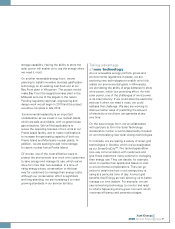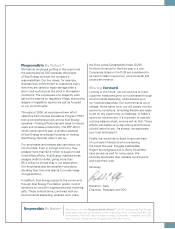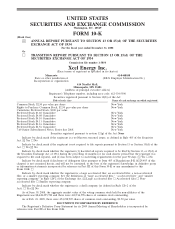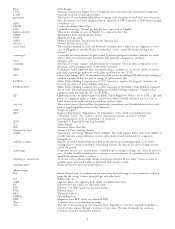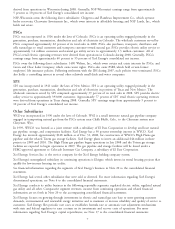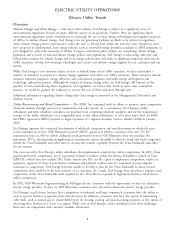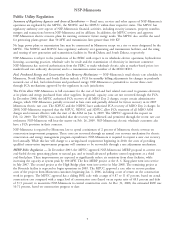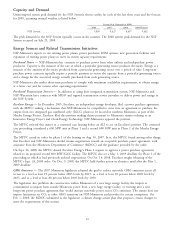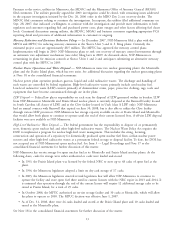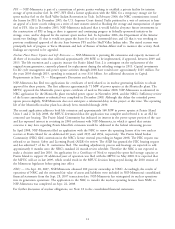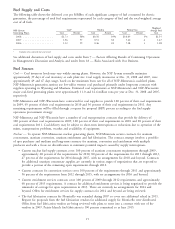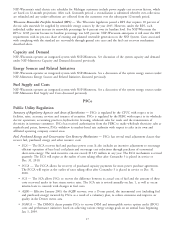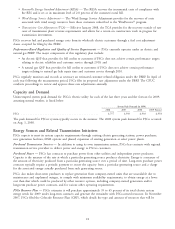Xcel Energy 2008 Annual Report Download - page 18
Download and view the complete annual report
Please find page 18 of the 2008 Xcel Energy annual report below. You can navigate through the pages in the report by either clicking on the pages listed below, or by using the keyword search tool below to find specific information within the annual report.ELECTRIC UTILITY OPERATIONS
Electric Utility Trends
Overview
Climate Change and Clean Energy — Like most other utilities, Xcel Energy is subject to a significant array of
environmental regulations focused on many different aspects of its operations. Further, there are significant future
environmental regulations under consideration to encourage the use of clean energy technologies and regulate emissions
of GHGs to address climate change. Xcel Energy’s electric generating facilities are likely to be subject to regulation
under climate change policies introduced at either the state or federal level within the next few years. Numerous states
have proposed or implemented clean energy policies, such as renewable energy portfolio standards or DSM programs, in
part designed to reduce the emissions of GHGs. Congress and federal policy makers are considering climate change
legislation and a variety of national climate change policies and regulations. Xcel Energy is advocating with state and
federal policy makers for climate change and clean energy policies that will result in significant long-term reduction in
GHG emissions, develop low-emitting technologies and secure, cost-effective energy supplies for our customers and our
nation.
While Xcel Energy is not currently subject to state or federal limits on its GHG emissions, we have undertaken a
number of initiatives to prepare for climate change regulation and reduce our GHG emissions. These initiatives include
emission reduction programs, energy efficiency and conservation programs, renewable energy development and
technology exploration projects. Although the impact of climate change policy on Xcel Energy will depend on the
specifics of state and federal policies, legislation, and regulation, we believe that, based on prior state commission
practice, we would be granted the authority to recover the cost of these initiatives through rates.
Additional information regarding climate change and clean energy is presented in the Management’s Discussion and
Analysis section.
Utility Restructuring and Retail Competition — The FERC has continued with its efforts to promote more competitive
wholesale markets through open-access transmission and other means. As a consequence, Xcel Energy’s utility
subsidiaries and their wholesale customers can purchase from competing wholesale suppliers and use the transmission
systems of the utility subsidiaries on a comparable basis to the utility subsidiaries’ to serve their native load. In 2008,
the FERC approved a MISO proposal to begin operation of a regional Ancillary Services Market (ASM) in January
2009.
Xcel Energy supports the continued development of wholesale competition and non-discriminatory wholesale open
access transmission services. NSP-Minnesota received MPUC approval in 2008 to construct three new 115 KV
transmission lines in 2009 to deliver additional wind generation even if NSP-Minnesota does not purchase the
generation. SPS is also pursuing strengthening its transmission system internally to alleviate north and south congestion
within the Texas Panhandle and other lines to increase the transfer capability between the Texas Panhandle and other
electric systems.
One state served by Xcel Energy’s utility subsidiaries has implemented retail electric utility competition. In 2002, Texas
implemented retail competition, but it is presently limited to utilities within the Electric Reliability Council of Texas
(ERCOT), which does not include SPS. Under current law, SPS can file a plan to implement competition, subject to
regulatory approval, in Texas. Local market conditions and political realities must be considered in proposing the
transition to competition. Xcel Energy has been unable to develop a plan for the Texas Panhandle to move toward
competition that would be in the best interests of its customers. As a result, Xcel Energy does not plan to propose retail
competition in the Texas Panhandle until required by law. New Mexico repealed its legislation related to retail electric
utility competition.
In 2002, NSP-Wisconsin began providing its Michigan electric customers with the opportunity to select an alternative
electric energy provider. To date, no NSP-Wisconsin customers have selected an alternative electric energy provider.
Xcel Energy’s retail electric business faces competition as industrial and large commercial customers have the ability to
own or operate facilities to generate their own electricity. In addition, customers may have the option of substituting
other fuels, such as natural gas or steam/chilled water for heating, cooling and manufacturing purposes, or the option of
relocating their facilities to a lower cost region. While each of Xcel Energy’s utility subsidiaries faces these challenges,
their rates are competitive with currently available alternatives.
8



